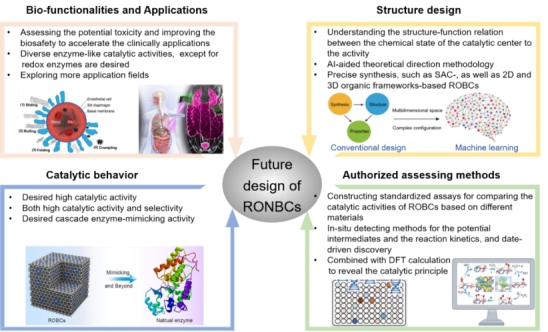The research team of Professor Li Qiu from the Department of Medical Ultrasound of West China Hospital recently published a review article titled "Reactive Oxygen Nanobiocatalysts: Activity-Mechanism Disclosures, Catalytic Center Evolutions, and Changing States" in Chemical Society Reviews, discussing systematically the research progress and future development direction of reactive oxygen nanobiocatalysts.

The corresponding authors are Prof. Li Qiu; Chong Cheng (research fellow) and Prof. Changsheng Zhao from the State Key Laboratory of Polymer Materials Engineering. The first authors are Sujiao Cao (research assistant) and Yanping Long, a master degree graduate from the Department of Medical Ultrasound. This research was funded by the National Natural Science Foundation of China, the Science and Technology Department of Sichuan Province, the National Postdoctoral Fund, and the 1.3.5 Plan of West China Hospital.
Biocatalysts have excellent catalytic activity and selectivity, participating in various biological reactions. The regulation of reactive oxygen species (ROS) mediated by them is significant for disease intervention and treatment. However, the shortcomings of easy deactivation, difficult storage, and high cost limit the practical application of biocatalysts. Developing new formulations and simulating biocatalysts for regulating ROS is of great significance.
“Benefiting from low costs, structural diversities, tunable catalytic activities, feasible modifications, and high stability compared to the natural enzymes, reactive oxygen nanobiocatalysts (RONBCs) have become dominant materials in catalyzing and mediating reactive oxygen species (ROS) for diverse biomedical and biological applications. Decoding the catalytic mechanism and structure–reactivity relationship of RONBCs is critical to guide their future developments. Here, this timely review comprehensively summarizes the recent breakthroughs and future trends in creating and decoding RONBCs. First, the fundamental classification, activity, detection method, and reaction mechanism for biocatalytic ROS generation and elimination have been systematically disclosed. Then, the merits, modulation strategies, structure evolutions, and state-of-art characterisation techniques for designing RONBCs have been briefly outlined. Thereafter, we thoroughly discuss different RONBCs based on the reported major material species, including metal compounds, carbon nanostructures, and organic networks. In particular, we offer particular insights into the coordination microenvironments, bond interactions, reaction pathways, and performance comparisons to disclose the structure–reactivity relationships and mechanisms. In the end, the future challenge and perspectives for RONBCs are also carefully summarised. We envision that this review will provide a comprehensive understanding and guidance for designing ROS-catalytic materials and stimulate the wide utilisation of RONBCs in diverse biomedical and biological applications.” (abstract)

Figure 1. Development History of RONBCs
Currently, more and more breakthroughs have been made in the use of RONBCs for catalytic removal of ROS. The composition, size, morphology, and coordination structure of catalytic sites of nanomaterials directly affect catalytic activity, and these influencing factors also provide ideas for the design of active sites (Figure 2).

Figure 2. Chemical composition and structural regulation strategies of common RONBCs
The article discusses the challenges and future development directions of RONBCs. They include: (1) in order to achieve clinical conversion quickly, it is necessary to develop RONBCs with specific therapeutic effects and good biocompatibility based on clinical needs, and their biological efficiency and safety evaluation in vivo and in vitro need to be further standardized; (2) Based on the current development of RONBCs, it is urgent to construct a database of RONBCs, and design and prepare a new generation of RONBCs with high catalytic activity and selectivity comparable to natural enzymes using advanced methods such as artificial intelligence and the oretical calculations;(3) Build adaptive, self-regulated, and cascaded RONBCs so as to break through the performance limitations of natural enzyme;(4) Further improve the evaluation system for the catalytic activity and mechanism of RONBCs; (5) Develop catalytic performance beyond the catalytic activity of RONBCs mimicking oxidoreductase, and further expand the application of RONBCs (Figure 3).

Figure 3. Future design of RONBCs
https://pubs.rsc.org/en/content/articlelanding/2023/CS/D3CS00087G
